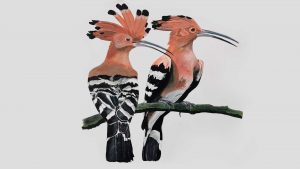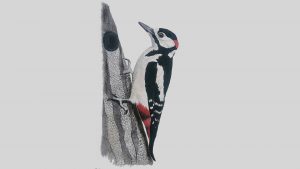03. Partridge
PAINTING 03
Partridge Bird
ABOUT THESE BIRDS
Some curiosities about partridges
This is a bird of great hunting interest, but also because it is very beautiful. Our great phasianidae partridge is partridge par excellence, which abounds in our fields. Their song is well known, especially when the males delight us with the proclamation of their territory and to impress the delicate females who choose them for their characteristics and strength to endow their offspring with their genes.
Partridges have a scientific name that alludes to their colouring Alectoris rufa, this appellative is a reminder of the red colour they have on their legs and beak that attracts enormous attention. Partridges also have very characteristic wing feathers, with black, white and reddish colours.
The differences between males and females can be seen in some aspects that are visible if you pay attention. For example, females do not have the rear spur on their legs that males do. If you look at this painting you will see that it is a female. Partridges are great mothers and are usually accompanied by their brood.
Partridges are abundant in our fields and their song is well known. Especially when the males delight us with the proclamation of their territory and to impress the delicate females. The females choose them for their characteristics and strength to provide their offspring with these genes. Partridges have a scientific name that alludes to their colouring Alectoris rufa. Red in Latin is rufa, this name being a reminder of the red colouration on the legs and beak which attracts a great deal of attention.
HOW IT WAS MADE
Discover how this painting was made
The partridge was a work I was very hesitant about because it seemed particularly large to me. But after measuring and reviewing many photos and videos I concluded that it was correctly proportioned.
As it is a very well known bird, I had the help of experts who guided me with the colours, size and details that allowed me to give it the realism that the work required. It has details to naturalise it, such as the poppy and the dandelion at its feet. These two herbaceous plants are illustrated in the style of the old botanical plates of 18th-century illustrators.
The partridge was a painting chosen by popular acclaim. While he was painting other works, everyone asked when he was going to paint a partridge. The partridge may look like a simple work, but it is not. As it is a well-known and easily recognisable bird, it is necessary to be very faithful to its anatomy and details. The painted specimen is a female in a field with flowers, alone. It is a young and strong specimen that is walking while pecking at some plants and seeds, the basis of its diet.
The partridge was painted with acrylic paints and markers and has a varnish treatment to protect it. It took seven days with a total of approximately 30 hours to complete. A grille that was on the façade had to be integrated. It is perhaps the most photographed and recognised work of the Casa de los Pájaros where it is next to the door.
ROUTE OF PAINTINGS
The Route of Paintings continues through Vélez-Blanco
This painting is located on the façade of the Casa de los Pájaros, it is next to a window and its dimensions are 1,70 and 1,90m. You can see other works of art by following our street route in Vélez Blanco.
BOOKINGS
Book your exclusive stay at The House of the Birds
You will discover a different kind of rural accommodation, with all the comforts of a completely restored house but with a rural feel. With fireplace, wine cellar, games room, table football room, spacious lounge, comfortable bathrooms, fully equipped kitchen and in the heart of a unique village with its beauty as is Vélez Blanco.



